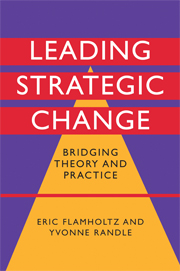Book contents
- Frontmatter
- Contents
- List of exhibits
- Preface
- Acknowledgments
- Part I An integrative framework for leading strategic and organizational change
- Part II Leading strategic change in actual organizations
- 4 Leading strategic and organizational change at Countrywide Financial Corporation
- 5 Leading change at Starbucks Coffee Company
- 6 Strategic marketing through HR interventions: a case study of Indian Oil Corporation
- 7 The evolution of Stan Tashman and Associates
- 8 Leading strategic and organizational change at IndyMac Bank
- 9 Leading strategic and organizational change at Infogix
- 10 Leading strategic and organizational change: the transformation of structure at Pardee Homes
- 11 Leading strategic and organizational change at Tata Steel: the role of culture
- 12 Leading strategic and organizational change at Westfield: transformation to a global enterprise
- Part III Leading strategic change: lessons learned from practice
- Appendix: References for further reading on leading change
- Index
6 - Strategic marketing through HR interventions: a case study of Indian Oil Corporation
from Part II - Leading strategic change in actual organizations
Published online by Cambridge University Press: 22 September 2009
- Frontmatter
- Contents
- List of exhibits
- Preface
- Acknowledgments
- Part I An integrative framework for leading strategic and organizational change
- Part II Leading strategic change in actual organizations
- 4 Leading strategic and organizational change at Countrywide Financial Corporation
- 5 Leading change at Starbucks Coffee Company
- 6 Strategic marketing through HR interventions: a case study of Indian Oil Corporation
- 7 The evolution of Stan Tashman and Associates
- 8 Leading strategic and organizational change at IndyMac Bank
- 9 Leading strategic and organizational change at Infogix
- 10 Leading strategic and organizational change: the transformation of structure at Pardee Homes
- 11 Leading strategic and organizational change at Tata Steel: the role of culture
- 12 Leading strategic and organizational change at Westfield: transformation to a global enterprise
- Part III Leading strategic change: lessons learned from practice
- Appendix: References for further reading on leading change
- Index
Summary
Introduction
Indian Oil Corporation (IOC) is India's first and only Fortune 200 company. IOC is India's largest and most prominent commercial undertaking, with over $41 billion in turnover, and it accounts for about 42 percent of India's refining capacity. It is the nineteenth largest petroleum company in the world and has been adjudged as the number one petroleum trading company amongst all the national oil companies in the Asia-Pacific region.
In spite of its size and economic strength, IOC was not immune to the winds of economic change. The dynamics of the external environment forced IOC's leaders to become acutely aware of the necessity to change their way of conducting business. The future success – and, indeed, the very survival – of IOC was in doubt.
IOC needed to change its business paradigm and transform itself from a mere distributor of petroleum products into a strategic marketing organization. The challenge was to bring about a rapid and thoroughgoing change in the way business was being conducted.
This chapter examines how this Asian behemoth with 30,000 employees and a “chaltha hai” (anything goes) culture transformed itself into a professional strategic marketing organization. Even though strategic change efforts were targeted throughout the entire organization, we focus in this chapter on the Marketing Division of the organization. Although this is a functional subunit of the company it is a key component of operations.
- Type
- Chapter
- Information
- Leading Strategic ChangeBridging Theory and Practice, pp. 99 - 122Publisher: Cambridge University PressPrint publication year: 2008



